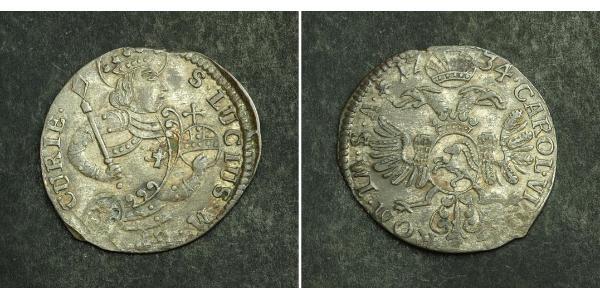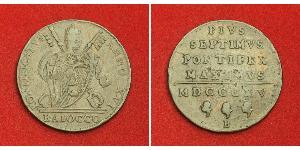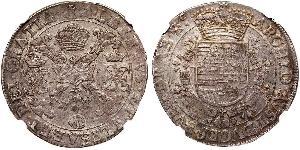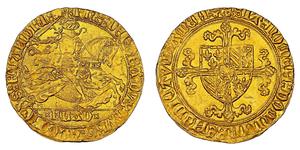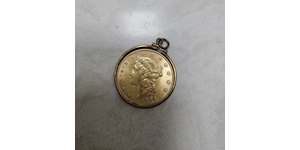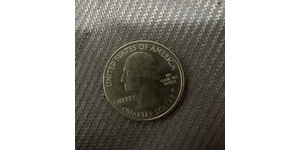(продана за $53.0)
1734, Switzerland, Graubunden, Chur (City). Silver 3 Kreuzer (Groschen) Coin.
Mint Year. 1734
State: Chur (City)
Region: Switzerland
Denomination: Bluzger
Reference: HMZ 2-498, KM-271. R!
Condition: Removed kreuzer value numeral (tooling spot), otherwise about XF!
Diameter: 22mm
Material: Silver
Weight: 1.7gm
Obverse: Nimbate, armored and crowned half-lenght bust of Saint Lucius right.
Legend: S . LUCIUS . M . EP . (3?) CURIE .
Reverse: Crown above double-headed eagle with crowned oval arms of Graubunden at chest.
Legend: CAROL . VI - ROM . IMP . S . A . * 17 - 34 .
Lucius is a legendary 2nd-century King of the Britons and saint traditionally credited with introducing Christianity into Britain. Lucius is first mentioned in a 6th-century version of the Liber Pontificalis, which says that he sent a letter to Pope Eleutherius asking to be made a Christian. The story became widespread after it was repeated in the 8th century by Bede, who added the detail that after Eleutherius granted Lucius' request, the Britons followed their king in conversion and maintained the Christian faith until the Diocletianic Persecution of 303. Later writers expanded the legend, giving accounts of missionary activity under Lucius and attributing to him the foundation of certain churches. There is no contemporary evidence for a king of this name, and modern scholars believe that his appearance in the Liber Pontificalis is the result of a scribal error. However, for centuries the story of this "first Christian king" was widely believed, especially in Britain, where it was considered an accurate account of Christianity among the early Britons. During the English Reformation, the Lucius story was used in polemics by both Catholics and Protestants; Catholics considered it evidence of papal supremacy from a very early date, while Protestants used it to bolster claims of the primacy of a British national church founded by the crown.
Chur or Coire is the capital of the Swiss canton of Graubünden and lies in the northern part of the canton.
The name "chur" derives perhaps from the Celtic kora or koria, meaning "tribe", or from the Latin curia.
Archaeological evidence of settlement at the site goes back as far as the Pfyn culture (3900-3500 BC), making Chur one of the oldest settlements in Switzerland. Remains and objects from the Bronze and Iron Ages have been found also in the eastern sector of the current city's centre. In Roman times it was a fortified camp, called Curia Raetorum; it has been suggested that under emperor Diocletian (late 3rd century AD) Chur was the capital of the province of Raetia.
In the 4th century Chur became the seat of the first Christian bishopric north to the Alps. Despite a legend assigning its foundation to an alleged Briton king, St. Lucius, the first known bishop is one Asinio in 451 AD. After the invasion of the Ostrogoths, it was rechristened Theodoricopolis; in the 6th century it was conquered by the Franks. The city suffered several invasions, by the Magyars in 925-926, when the cathedral was destroyed, and by the Saracens (940 and 954), but afterwards it flourished thanks to its location, where the roads from several major Alpine transit routes come together and continue down the Rhine river. The routes had been already used under the Romans but acquired greater importance under the Ottonian dynasty of the Holy Roman Empire. Emperor Otto I appointed his vassal Hartpert as bishop of Chur in 958, giving the bishopric numerous privileges. In 1170 the bishop became a prince-bishop and kept total control over the road between Chur and Chiavenna.
In the 13th century the town had some 1,300 inhabitants, and was surrounded by a line of walls. In 1367 the foundation of the Three Leagues in the area was a first step towards Chur's autonomy: a burgmeister (mayor) is first mentioned in 1413, and the bishop's residence was attacked by the inhabitants in 1418 and 1422, when a series of concessions were wrung out of him. Chur was the chief town of the Gotteshausbund or Chadé (League of the House of God), and one of the places the Leagues' assemblies met regularly. As the power of the bishops, now increasingly under the influence of the nearby Habsburg County of Tyrol, decreased, in 1464 the citizens wrote a constitution which was adopted as the rule for the local guilds and political positions. In 1489 Chur obtained the right to have a tribunal of its own, but never had the title of Free Imperial City. Chur adhered to the Reformation in the 16th century, and the Catholic bishopric had to leave the city in 1524. In the same century the German language started to prevail over Romansh. Despite two fires in 1464 and 1574, the city developed economically until the Thirty Years' War, when it was destroyed and struck by plagues.
During the period of the Republic of the Three Leagues in Graubünden (ca. 1400-1797), Chur was the chief town of the Gotteshausbund or Chadé (League of the House of God), and one of the places the Leagues' assemblies met regularly. The guild constitution of the city of Chur lasted until 1839, while in 1874 the Burgergemeinde was replaced by an Einwohnergemeinde. When Graubünden became a canton in 1803, Chur was chosen as its capital.
Only 1$ shipping on each additional purchease!

|
Добавив:
anonymous 2016-02-16 |
8 монет було додано з 2025-06-25 по 2025-07-02
Одна з них:
536 монет було додано з 2025-06-11 по 2025-06-18
Одна з них:

